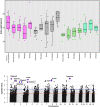This is a preprint.
Across two continents: the genomic basis of environmental adaptation in house mice (Mus musculus domesticus) from the Americas
- PMID: 37961195
- PMCID: PMC10634997
- DOI: 10.1101/2023.10.30.564674
Across two continents: the genomic basis of environmental adaptation in house mice (Mus musculus domesticus) from the Americas
Update in
-
Across two continents: The genomic basis of environmental adaptation in house mice (Mus musculus domesticus) from the Americas.PLoS Genet. 2024 Jul 5;20(7):e1011036. doi: 10.1371/journal.pgen.1011036. eCollection 2024 Jul. PLoS Genet. 2024. PMID: 38968323 Free PMC article.
Abstract
Parallel clines across environmental gradients can be strong evidence of adaptation. House mice (Mus musculus domesticus) were introduced to the Americas by European colonizers and are now widely distributed from Tierra del Fuego to Alaska. Multiple aspects of climate, such as temperature, vary predictably across latitude in the Americas. Past studies of North American populations across latitudinal gradients provided evidence of environmental adaptation in traits related to body size, metabolism, and behavior and identified candidate genes using selection scans. Here, we investigate genomic signals of environmental adaptation on a second continent, South America, and ask whether there is evidence of parallel adaptation across multiple latitudinal transects in the Americas. We first identified loci across the genome showing signatures of selection related to climatic variation in mice sampled across a latitudinal transect in South America, accounting for neutral population structure. Consistent with previous results, most candidate SNPs were in regulatory regions. Genes containing the most extreme outliers relate to traits such as body weight or size, metabolism, immunity, fat, and development or function of the eye as well as traits associated with the cardiovascular and renal systems. We then combined these results with published results from two transects in North America. While most candidate genes were unique to individual transects, we found significant overlap among candidate genes identified independently in the three transects, providing strong evidence of parallel adaptation and identifying genes that likely underlie recent environmental adaptation in house mice across North and South America.
Keywords: adaptive evolution; climate; environment; parallelism.
Figures





Similar articles
-
Across two continents: The genomic basis of environmental adaptation in house mice (Mus musculus domesticus) from the Americas.PLoS Genet. 2024 Jul 5;20(7):e1011036. doi: 10.1371/journal.pgen.1011036. eCollection 2024 Jul. PLoS Genet. 2024. PMID: 38968323 Free PMC article.
-
The genomics of rapid climatic adaptation and parallel evolution in North American house mice.PLoS Genet. 2021 Apr 29;17(4):e1009495. doi: 10.1371/journal.pgen.1009495. eCollection 2021 Apr. PLoS Genet. 2021. PMID: 33914747 Free PMC article.
-
The genomic basis of high-elevation adaptation in wild house mice (Mus musculus domesticus) from South America.Genetics. 2022 Feb 4;220(2):iyab226. doi: 10.1093/genetics/iyab226. Genetics. 2022. PMID: 34897431 Free PMC article.
-
Ecological genetics in the North Atlantic: environmental gradients and adaptation at specific loci.Ecology. 2008 Nov;89(11 Suppl):S91-107. doi: 10.1890/07-1162.1. Ecology. 2008. PMID: 19097487 Review.
-
Understanding the Adaptive Evolutionary Histories of South American Ancient and Present-Day Populations via Genomics.Genes (Basel). 2021 Mar 2;12(3):360. doi: 10.3390/genes12030360. Genes (Basel). 2021. PMID: 33801556 Free PMC article. Review.
References
-
- Alexa A, Rahnenfuhrer J. topGO: Enrichment Analysis for Gene Ontology. 2023. R package version 2.52.0.
-
- André E, Conquet F, Steinmayr M, Stratton SC, Porciatti V, Becker-André M. Disruption of retinoid-related orphan receptor beta changes circadian behavior, causes retinal degeneration and leads to vacillans phenotype in mice. EMBO J. 1998;17:3867–3877. doi: 10.1093/emboj/17.14.3867. - DOI - PMC - PubMed
Publication types
Grants and funding
LinkOut - more resources
Full Text Sources
Miscellaneous
